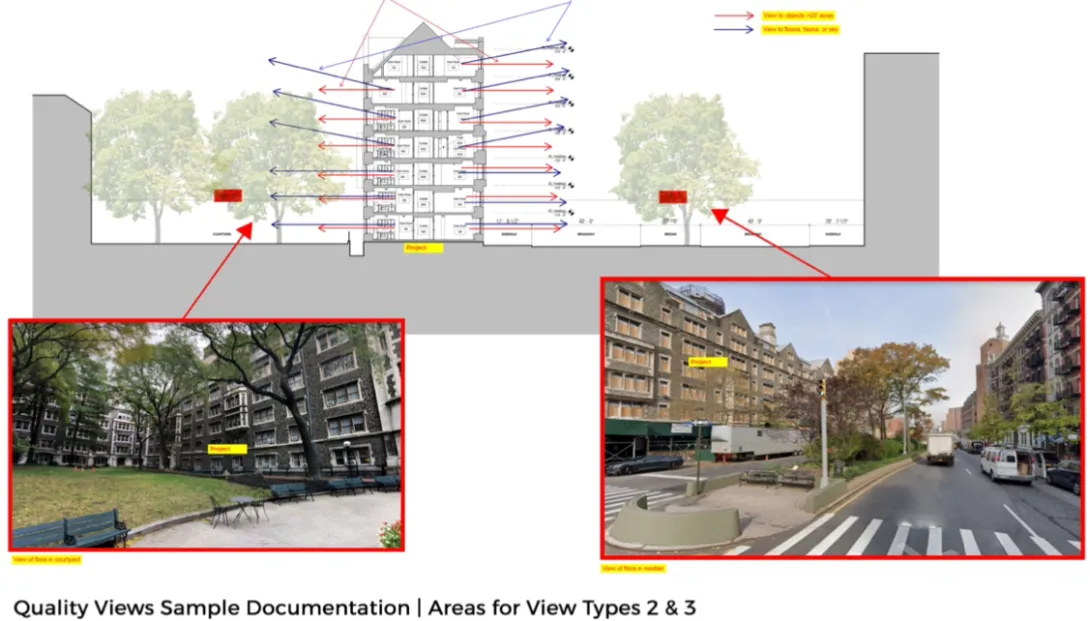Quality Views: New LEED Sample Is a Window into the Credit

An excerpt from the sample documentation for the v4 Quality Views credit
Everyone wants a window.
But the design strategies for ensuring everyone gets one—particularly in a shared open office—are far from straightforward. Plus, that extra glazing is hardly worth it if people see nothing but a brick wall or an acre of parked cars. Human beings who find themselves stuck in buildings all day long typically want a connection to something restorative or inspiring.
Complying with the LEED v4 or v4.1 Quality Views credit adds yet another layer of complexity to the design workflow for providing views. To earn the point, you must demonstrate that you’ve met the strict requirements.
First: the newer, “easier” version
In v4.1 (which is similar to but simpler than the v4 version), these strict requirements are:
- a view to nature, urban landmarks, or art for 75% of all regularly occupied floor area
- excludes space types that need to be dark at times
- allows atria to count for 30%
- must create a sense of “prospect” by ensuring the natural element, landmark, or artwork is 25+ feet away from the glazing
- visible light transmittance (VLT) above 40%
- no fritting, patterns, or tints that distort or block the view
- direct access within three times the head height of the glazing
A word of wisdom from our Viewpoint on this credit: “The key is knowing how to efficiently group regularly occupied areas in parallel with the daylight credit (if pursued). Thinking about this during the programming phase can greatly enhance the outcomes.”
What about v4?
The older version of this credit is similar in several ways but can be quite a bit more complex to interpret and document because it is based on various view “types,” and it requires the project team to provide two of these types. In other ways, the guidance is less specific than in the v4.1 credit language and can therefore confuse the issue. The v4 version in a nutshell:
- at least two kinds of views (numbered below) for 75% of all regularly occupied floor area
- allows atria to count for 30% (no exemption, as in v4.1, for auditoriums, etc.)
- includes permanent obstructions
- excludes movable furniture and partitions
- a “clear image” (but no clear metric to strive for)
- no fritting, patterns, or tints that distort the color balance
The four v4 view types are:
- multiple lines of sight in different directions
- views to two of these:
- flora, fauna, or sky
- movement
- objects at least 25 feet away
- views within three times the head height of the vision glazing (a requirement, not an optional view type, in v4.1)
- views that have a “view factor” of 3 or higher as defined on page 48 of this 2003 technical report prepared for the State of California
What was that again … ?
Exactly.
If you’re pursuing the v4 version, check out our new documentation sample (which premium subscribers can download for free) from a certified project that our partner WSP has graciously shared. It shows you a real-world example of how to do the calculations—and then show your work—for view types 2 and 3.
Although this sample is less useful for the v4.1 version, many of the same principles hold—including how to demonstrate that you’ve met the 75% threshold and that no permanent obstructions are blocking the view. So it could be helpful for those details, even if you’re working under the simplified v4.1 rules about view types.
Are you struggling with either version of the Quality Views credit? Check out the v4 or v4.1 forum, whichever is applicable, and post a question if need help!
